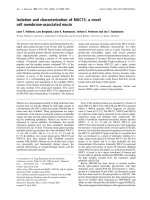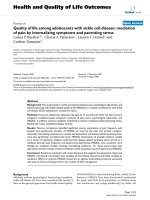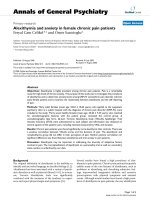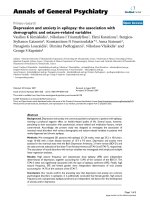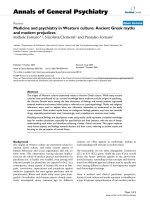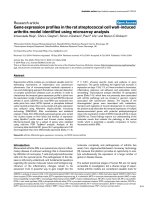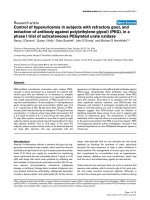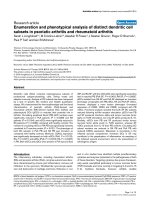Báo cáo y học: " Depression and loneliness in Jamaicans with sickle cell disease" potx
Bạn đang xem bản rút gọn của tài liệu. Xem và tải ngay bản đầy đủ của tài liệu tại đây (272.07 KB, 7 trang )
RESEARC H ARTIC LE Open Access
Depression and loneliness in Jamaicans with
sickle cell disease
Monika R Asnani
*
, Raphael Fraser, Norma A Lewis, Marvin E Reid
Abstract
Background: Sickle cell disease (SCD) is the commonest genetic disorder in Jam aica, and has life-long implications
for those afflicted with it. It is well known that depression and loneliness may exist in those with chronic diseases,
but the coexistence of depression and loneliness in people with sickle cell disease is not clear. The aim of this
study is to determine the prevalence of and factors associated with depression and loneliness in the Jamaica Sickle
Cell Cohort Study and its age and sex matched controls.
Methods: 277 patients with SCD and 65 controls were administered a questionnaire that studied demographics,
disease severity, depression, and loneliness. Regression analyses were done to examine relationships between
outcomes and associated variables.
Results: Depression was found in 21.6% of patients and 9.4% in controls. Loneliness scores were also significantly
higher in patients (16.9 ± 5.1) than in controls (14.95 ± 4.69). Depression was significantly associated with
unemployment [OR = 2.9, p-value: < 0.001], whereas unemployment (p-value: 0.002), and lower educational
attainment were significantly associated with loneliness.
In patients with SCD, depression was significantly associated with being unemployed (OR 2.4, 95% CI 1.2,4.6, p-
value:0.01), presence of a leg ulcer (O R = 3.8, 95% CI: 1.7, 8.4, p-value: 0.001), frequent visits (OR = 3.3, 95% CI: 1.2,
8.9, p-value: 0.019), and frequent painful crises (OR = 2.5, 95% CI: 1.1, 5.8, p-value: 0.035). Not being employed
(Coef.: 2.0; p-value: 0.004) and higher educational attainment (tertiary vs. primary education, Coef.: -5.5; p-value: <
0.001) were significant associations with loneliness after adjusting for genotype.
Conclusions: Health workers need to actively look for and manage these problems to optimize their pat ients’ total
biopsychosocial care.
Background
Sickle Cell Disease (SCD) is a chronic and potentially,
quite a debilitating disease. The disease is severe and
may result in significant morbidity, as well as a shor-
tened life span. There is considerable variability in the
clinical course of sickle cell disease with some patients
experiencing few to no complications and others having
multiple organ involvement [1]. Painful crises, lung dis-
eases such as Acute Chest Syndrome, leg ulcerations,
and priapism are common complications of the disease
in Jamaica. These and other complications contribute a
lot to the social isolation and lack of normal functioning
in these patients.
Depression is one of the most common complica-
tions of chronic illnesses [2-4]. According to one sur-
vey[2],depressionwasfoundtobecommonin
patients diagnosed with: recent heart attacks (45%),
hospitalized cancer patients (42%), recent stroke survi-
vors (40%), and people with multiple sclerosis (40%),
Parkinson’s disease (40%), and diabetes (33%). Depres-
sion caused by chronic illness often aggravates the ill-
ness, especially if the condition causes pain, fatigue, or
disruption of social life.
The prevalence of depression in SCD patients has
been reported to be high [5-9]. The Pain in Sickle Cell
Epidemiology Study has also shown the prevalence of
depression (as assessed by studying daily diaries) to be a
high of 27.6% [10]. Hilton et al (1997) have reported on
the prevalence of overall psychiatric morbidity in
patients with SCD in Jamaica but not of depression [11].
* Correspondence:
Sickle Cell Unit, Tropical Medicine Research Institute, University of the West
Indies, Mona Campus, Kingston 6, Jamaica (W.I
Asnani et al. BMC Psychiatry 2010, 10:40
/>© 2010 Asnani et al; licensee BioMed Central Ltd. This is an Open Access article distributed under the terms of the Creative Commons
Attribution License (http://creative commons.org/licenses/by/2.0), which p ermits unrestricted use, distribution, and reproduction in
any medium, provided the original work is properly cited.
Loneliness is a measure of being cut off or separated
from others. It refers to a deficiency of social contact
compared to what is desired [12], and is fundamentally
an aversive and distressing experience with potentially
serious consequences [13]. As such it is a distinct psy-
chological problem from depression. Loneliness has
been linked to a number of somatic and psychological
difficulties and has been associated with lower reported
life satisfaction, suicide and alcoholism [14]. A few stu-
dies have shown loneliness to be increased in patients
with acute or chronic diseases [15-17]. Loneliness and
depression also have been found to co-exist in a number
of populations [18-20]. In SCD, depression and loneli-
ness may be a s a result of living with a chronic disease
itself, or may be a result of societal and heal th care pro-
viders’ response to these persons [9,21].
No studies have looked at the co-existence of depres-
sion and loneliness in SCD and it is hypothesized that
depression and loneliness will have a high prevalence
and coexist in this population. In this study therefore,
we have sought to determine the prevalence of depres-
sion and loneliness i n a birth cohort of patients with
SCD in Jamai ca and compare it to i ts age- and sex-
matched s et of controls. We have also sought to deter-
mine possible socioeconomic and clinical factors asso-
ciated with depression and loneliness in this disease
group.
Methods
Sampling
The Jamaica Sickle Cell Cohort Study (JSCCS) incorpo-
rates all patients with SCD detected during the screen-
ing of 100,000 consecutive deliveries at the Victoria
Jubilee Hospital - the country’s main government mater-
nity hospital - from June 1973 to December 1981. This
screening identified 552 cases with SCD, 315 children
with homozygous sickle cell (SS) disease, 178 with sickle
cell-haemoglobin C (SC) disease, 33 with sickle cell-beta
+ thalassaemia (S beta+ thal) and 14 with sickle cell-
beta
0
thalassaemias ( S beta
0
thal). These patients have
been closely followed since birth and are seen at the
only comprehensive sickle cell clinic (SCU) located at
theUniversityoftheWestIndies in Kingston, Jamaica
for routine health maintenance checks and for all signif-
icant sick events in an effort to document the natural
history of the disease. They are actively located if they
have not presented to the SCU for more than 6 months-
1 year. 277 patients were available (the rest having been
lost mainly to emigration and death), and all took part
in the study where they were administered the study
questionnaire comprising questions on socio-demo-
graphics, disease severity, depression and loneliness.
At the initial recruitment of the JSCCS, the first 125
SS babies were each matched with two controls with an
AA phenotype of the same sex born closest in time
(usually immediately before and after) resulting in 250
controls collected over the first 21/2 years. 64 of these
controls are still a vailable and were also administered
the questionnaire including questions on socio- demo-
graphics, depression and loneliness.
Data collection
The demographic data collected included age, sex, mari-
tal status, genotype, employment status, and the highest
educ ational level they had attained. Questions were also
included on their utilization of the clinic (SCU) services,
frequency of painful crises, and whether they had leg
ulceration as a result of the ir sickle cell disease. Pain
was defined as ‘severe bony pains requiring opiod
analgesia for relief’, and was categorized as being ‘Rare’
if they rarely had bony pains or ‘Frequent’ if they suf-
fered a painful crisis at least once monthly. Similarly,
utilization of the clinic services was categorized as ‘≤ 1-3
times/year’ (Rare) or ‘≥ once/month’ (Frequent). Depres-
sion was measured using the 21-point B eck Depression
Inventory-versi on II (BDI), and lone liness using the
UCLA-8 Loneliness scale (UCLA).
Beck Depression Inventory-II
The BDI is one of the most commonly utilized measure
of depression among adolescents and adults by clini-
cians and researchers alike [22]. The BD I-II has demon-
strated high internal consistency, good test-retest
reliability, and good construct and concurrent validity
with other common measures of depression in clinical
and nonclinical samples [23]. Discriminant v alidity has
also been demonstrated through weaker relationships
with measures of other psychopathology, such as anxiety
[24]. In Jamaica, the BDI has been validated previously
in a sample of university students [25].
UCLA-8 Loneliness Scale
A widely used loneliness measure is the UCLA loneli-
ness scale developed by Russell & colleagues [26,27].
Psychometric analyses including confirmatory factor
analyses have confirmed that this is a reliable and valid
measure of loneliness across a variety of populations
[28-30]. Hays and DiMatteo [12] have developed an
eight-item short form of the UCLA-20, the U CLA-8,
which h as been shown to be highly correlated with the
original form (r = 0.91). Scores on the UCLA-8 are also
well distribu ted, ranging from 0% to 100% of the maxi-
mum possible. The UCLA-8 is a practical alternative to
the UCLA-20 and reduces respondent burden. The lat-
ter may lead to improved quality of data being collected.
Although the estimated reliab ility of the UCLA-8 is a
little lower than that of the UCLA-20, there is greater
homogeneit y in this measure [12]. Cross-cultural studies
have shown the stability of the measure across countries
and cultures [31,32].
Asnani et al. BMC Psychiatry 2010, 10:40
/>Page 2 of 7
The controls were g iven the questionnaire that
included information only on socio-demographics as
well as the BDI and UCLA. Both instruments showed
acceptable internal consistency reliabilities in SCD (BDI:
a = 0.95; UCLA: a = 0.82 ) as well as in the AA (BDI: a
= 0.90; UCLA: a = 0.78) group. Higher scores on the
BDI and UCLA imply worsening depression and loneli-
ness respectively.
Written, informed consent was obtained prior to
administering the questionnaire that had been pretested.
Complete confidentiality was maintained throughout the
study. The study was granted ethical approval by the
University of the West Indies/University Hospital of the
West Indies Ethical Committee.
Statistical analyses
Descriptive statistics are reported as frequency and per-
cent for categoric al data and as mean and SD for con-
tinuous data. Continuo us variables were compared by
Student’s t test. Pearson correlations were used to assess
linear associations between the two scales. Age, g ender,
hig hest educational level achieved, group (SCD vs. AA),
employment status, frequency of visit to SCU, pain
crises frequency and other symptoms characte ristic of
SCD were used as covariates in our regression models.
Depression and loneliness were the outcomes of interest.
Theanalyseswerefirstdoneontheentiregroupthen
on the SCD subgroup. As the author Aaron Beck has
stated that the BDI has no stringent cut-offs, a higher
score of 17 was used to allow greater specificity to diag-
nosis. Also, in chronic illnesses that have somatic symp-
toms, the BDI may give falsely elevated scores [33,34],
and as SCD does cause symptoms such as fatigue and
loss of energy, a higher cut-off of 17 was utilized. Logis-
tic regression was used to examine the relationship
between independent variables and depression, and mul-
tivariate linear regression to examine the possible factors
associated with loneliness. Data was analyzed using Stata
Software version 10 for Windows™ (StataCorp, College
Station, TX).
Results
The study sample consisted of 277 patients with SCD
(mean age 31 years) and 65 patients with normal AA
genotype (mean age 33.6 years), with equal proportions
of males and fe males in each subgro up (Table 1). A sig-
nificantly greater proportion of the controls had higher
levels of educational attainment and was employed.
The mean depression score (9.19 ± 10.4, Range 0, 50)
was significantly higher in SCD than in AA controls (6.4
± 7.9, Range 0, 41), with almost twice the proportions of
SCD persons being depressed as compared to the con-
trols. The mean loneliness score was also significantly
higher in SCD (16.9 ± 5.1) than in AA controls (14.95 ±
4.69). The Pearson’s correlation between the two scales
was 0.39 for those with SCD implying that the two
scales were probably not measuring a similar concept.
The distribution of BDI scores in those with SCD is
shown in Figure 1. Further comparisons were done
within the SCD cohort to determine differences between
those who were not depressed (BDI scores (mean ± SD):
4.6 ± 4.7) and those depressed (BDI scores (mean ± SD):
25.8 ± 8.2) (Table 2). There were no differences in age,
sex, genotype and marital status of those ‘not depressed’
and t hose ‘depressed ’. Howev er, depressed patients had
significantly lower levels of educational attainment (p-
value 0.002) and more were unemployed (p-value
0.001). Those depressed had worse disease as evidenced
by having higher proportion of leg ulceration (p-value
0.006), higher frequency of painfu l crises (p-value <
0.001) and more frequent visits to the SCU (p-value <
0.001). The depressed patients also had significantly
higher mean loneliness scores (mean score: 16.1 vs. 20.1,
p-value < 0.0001).
Depression and loneliness
The relationship between the various factors (age, gen-
der, highest educational level achieved, group [SCD vs.
AA], employment status) and depression was explored
with a series of logistic regression models, and their
relationship with loneliness was explored with multivari-
ate linear regression. In the final model, not being
employed was the only factor significantly associated
with depression in the study sample [OR = 2.9 (95% CI:
1.6, 5.1) p-value: < 0.001], adjusting for presence of SCD
(Table 3). Not being employed was also a significantly
associated with loneliness (p-value: 0.002), where as
higher l evels of educat ional attainment were associated
with lower levels of loneliness (Table 4). Higher depres-
sion scores were associated with higher loneliness scores
(regression coef.; 0.78; p value < 0.001).
Table 1 Summary of patient characteristics
SCD
(N = 277)
AA
(N = 65)
Age in years, mean (SD)*** 31.0 (2.50) 33.6 (0.67)
Gender (female/male) 140/137 37/28
Employment (yes/no)*** 157/107 58/7
Educational status**
Primary 35 -
Secondary/High 121 34
Post Secondary/Skills training 84 18
Tertiary 24 12
Depression score*, mean (SD) 9.19 (10.38) 6.42 (7.94)
Proportion depressed* 21.6% 9.4%
Loneliness score**, mean (SD) 16.94 (5.10) 14.95 (4.69)
p < 0.05, ** p < 0.01, *** p < 0.001
Asnani et al. BMC Psychiatry 2010, 10:40
/>Page 3 of 7
Depression and loneliness in SCD
The odds ratios (OR) for the factors that were signifi-
cantly related to depression (Table 5), adjusting for gen-
otype, were being unemployed (OR 2.4, 95% CI 1.2,4.6,
p-value:0.01), p resence of leg ulcer (OR = 3.8 (95% CI:
1.7, 8.4, p-value: 0.001), frequent visits to the sickle cell
unit (OR = 3.3, 95% CI: 1.2, 8.9, p-value: 0.019), and fre-
quent painful crises (OR = 2.5, 95 % CI: 1.1, 5.8, p-value:
0.035).
Multivariate linear regression yielded, once again, not
being employed (Coef: 2.0, p-value: 0.004), and higher
educational attainment (vocational/skills training com-
pared to primary education Coef: -2.3, p-value: 0.028;
tertiary education compared to primary education,
Coef: -5.5, p-value: < 0.001) as factors significantly
associated with loneliness after adjusting for genotype
(see Table 6).
Discussion
The primary aim of this study was to examine the pre-
valence of depression and loneliness in adult patients
with Sickle Cell Disease in Jamaica and compare it to an
age-matched set of controls.
Depression was found in a significantly higher propor-
tion of patients with SCD (21.6%) than in controls
(9.4%). The latter compares well to other studies that
have shown the prevalence of depression in the general
Jamaican population to be at 8% [35]. Previous studies
[5] using the BDI have reported prevalence of
depressioninSCDtobeat44%,butusingacutoff
score of 14. Wilson Schaeffer et al (1999) found the pre-
valence to be at 43.4%, which fell to 18% using a more
stringent cut-off. They used the Centre for Epidemio lo-
gic Studies - Depression scale (CES-D) as their tool and
studied 440 adults. The mean age of this sample how-
ever, was much higher at 33.7 (SD = 11.5 ). Most of pre-
vious studies possibly have a symptomatic bias
attributable to the recruitment of patients from a clinic
population. This is in contrast to our study where we
have examined a well birth cohort of patients which has
been followed up actively over the years. This has
allowed for this study to include those people with SCD
who tend to have good physical health.
Similarly, patients with SCD have shown higher levels
of loneliness than their controls. To our knowledge,
there are no previous reports of loneliness among this
patient group. Loneliness seems to be strongly related to
a broad range of negative em otional and cognitive states
such as depression and anxiety [26], and it has been
suggested that loneliness and depression may act syner-
gistically to diminish well being [36]. Our study has also
shown a moderately high correlation between loneliness
and depression, and higher levels of loneliness among
those who are depressed. Even though most studies on
loneliness have been done in nursing home residents
and the elderly, socially isolated young adults have
shown higher rates of mortality [37,38], even after
adjusting for other risk factors for death. Lonelier
Figure 1 Distribution of BDI scores in SCD.
Asnani et al. BMC Psychiatry 2010, 10:40
/>Page 4 of 7
persons have shown lower cardiovascular function
(higher total peripheral resistance and lower cardiac out-
put) [39], as well as lower immune and higher stress
levels [40]. It remains to be seen if loneliness may lower
immune response, cardiovascular resilience, etc. in
patients with SCD.
It is important to note that lack of employment was a
significant factor associated with higher levels of depres-
sion and loneliness irrespective o f having SCD or not.
Also, those with lower levels of educational attainment
tended to b e lonelier. Previous studies have also con-
firmed that poore r social an d economic circumstances
lead to higher levels of depression, as well as worse dis-
ease outcomes [8,10,41]. It is important against this
background that health care professionals remain vigi-
lant to proper school attendance and educational attain-
ment of young children with SCD, so as to enable them
for better employment opportunities in the future.
Depression, loneliness and SCD
Another aim of the study was to examine variables that
were significantly associated with depression and loneli-
ness in those with SCD. Being unemployed, having leg
ulcerations, more fr equent painful crise s, and frequently
visiting SCU for health care were all positively asso-
ciated with depression in those with SCD. Once again,
Table 2 Sociodemographic and clinical variables in
persons with SCD
Nil Depression Depression p-value
Age in years, mean(SD) 30.9 (2.5) 31.1(2.5) 0.582
Sex, Male:Female 105:102 23:34 0.165
Genotype, n (%) 0.917
SS 117 (56.5) 33 (57.9)
SC 64 (31) 18 (31.6)
Others 26 (12.5) 6 (10.5)
Marital Status, n (%) 0.742
Single 184 (88.9) 52 (91.2)
Married 21 (11.1) 5 (8.8)
Educational Status, n (%) 0.002
Primary 26 (12.6) 9 (15.8)
Secondary/High 85 (41.0) 36 (63.2)
Vocation/Skills 72 (34.8) 12 (21.0)
Tertiary 24 (11.6) 0 (0)
Employment status, n (%) 0.001
Yes 134 (64.7) 23 (40.4)
No 73 (35.3) 34 (59.6)
Leg Ulcers, n (%) 0.006
No 175 (84.5) 39 (68.4)
Yes 32 (15.5) 18 (31.6)
Pain Category, n (%) <0.001
Rare 180 (87) 36 (63.2)
Frequent 27 (13) 21 (36.8)
Visits to SCU, n (%) <0.001
Rare (≤1-3 times/year) 192 (92.8) 42 (73.7)
Frequent (≥Once/month) 15 (7.2) 15 (26.3)
Loneliness Score, mean (SD) 16.1 (4.8) 20.1 (5.2) <0.0001
Table 3 Predictors of depression adjusting for presence
of disease (SCD + AA)
Variable OR 95% CI p-value
Not employed 2.9 1.6, 5.1 <0.001
Presence of SCD 1.9 0.8, 4.8 0.17
Table 4 Predictors of loneliness adjusting for presence of
disease (SCD+AA)
Variable Coefficient 95% CI p-value
Not employed 1.96 0.7, 3.2 0.002
*Education level
Vocation/Skills -2.2 -4.2, -0.24 0.03
Tertiary -6.4 -9.0, -3.8 <0.001
Presence of SCD 0.66 -0.7, 2.1 0.35
*Compared to ‘Primary education’
Table 5 Predictors of depression in SCD adjusting for
genotype
Variable OR 95% CI p-value
Not employed 2.4 1.2, 4.6 0.010
Presence of leg ulcers 3.8 1.7, 8.4 0.001
*Frequent visits to the unit
(≥ once/month)
3.3 1.2, 8.9 0.019
**Frequent pains (≥ once monthly) 2.5 1.1, 5.8 0.035
***SC genotype 2.5 1.1, 5.4 0.027
• *Compared to ‘Visits 1-3 times a year’;
• ** Compared to ‘Rare pains’;
• ***Compared to ‘SS genotype’
Table 6 Predictors of loneliness in SCD adjusting for
genotype
Variable Coefficient 95% CI p-value
Not employed 2.0 0.6, 3.4 0.004
*Education level
Vocation/Skills -2.3 -4.4, -0.3 0.028
Tertiary -5.5 -8.4, -2.5 <0.001
*Compared to ‘Primary education’
Asnani et al. BMC Psychiatry 2010, 10:40
/>Page 5 of 7
unemployment and lower educational attainment were
associated wit h greater loneliness scores among this dis-
ease population. Gender, age and marital status have
shown no associations with either of these outcomes.
More frequent pa inful crises and visiting the unit
more frequently were positively associated with depres-
sion. Depressive symptoms often complicate chronic
pain, and may l ower the t hreshold and tolerance for
pain. These observations have been consistent in pre-
vious studies [5,8,10,42]. Our study has also shown leg
ulceration to be significantly associated with depression
and it was a frequent complicati on of SCD in this study
population (18.9%). Although leg ulceration is not a
complication that is associated with high mortality in
SCD, it is a frequent and chronic condition that leads to
a huge degree of morbidity especially in yo unger people
with SCD [43]. These persons have also been shown to
have lower educational attainment and inability t o form
stable marital relations [44].
A surprising finding from this study was the fact t hat
heterozygous SC disease (as compared to SS Disease)
was significantly associated with grea ter depression
(OR 2.5, 95% CI 1.1,5.4, p-value:0.027), even though
both SS and SC have demonstrated same frequency of
depression (22%) in this study sample. This is despite
the fact that those with SC disease were more likely to
be employed, and had less severe disease as evidenced
by less frequent visits to the unit, less frequent painful
crises and lower prevalence of leg ulceration (results
not shown). This finding may point to lower coping
mechanisms in those wit h the less severe form of dis-
ease; past findings have also similarly pointed to
greater psychological distress among those with milder
genotypes of SCD [8,45]. Severity of disease is not
always correlated to psychological adjustment or cop-
ing, and maybe those with more severe illness have
better social suppor t systems and may have learnt bet-
ter stress-management strategies to help them with
their illness [45]. Further studies would enable us to
gain understanding into mechanisms of depression in
thisdiseasepopulationandhowthesemayvaryamong
different genotypes.
The main limitations of this stud y relate to the instru-
ment used to assess depression and the characteristics
of the sample studied. Even though the BDI is a valid
instrument [46] for measuring the degree of depression,
a structured clinical interview would have been more
diagnostic. The second limitation is that the study was
conducted in the cohort where the oldest person studied
was 35 years of age. The study needs to be extended to
older age groups as well. A bias that using the cohort
has introduced in the study is the surviv al bias, as those
who had been lost due to mortality and migration were
missed out in the study, and these individuals may have
had more severe (in case of those who died) or variable
severity (in case of those who migrated) disease.
Conclusions
This study confirms the fact that SCD is a chronic dis-
ease where the prevalence of depression and loneliness
increases to higher levels than in the general population.
The depressive symptoms in this population show sig-
nificant association with demographic variables such as
educational st atus, and employment. Health care pro fes-
sionals working with the SCD population need to be
aware of these factors. They need to ensure con tinuing
education of the patients, and hence increase further
their abilit y to have worthwhile employment. These fac-
tors need to be at th e forefront of all health surveillance
visits from childhood. Even though a myriad of studies
have shown that chronic diseases often co-exist with
depression, sadly this evidence has not translated into
practice [47], as these feelings of depres sion, anxiety etc.
may be trivialized o r ignored in the bigger picture of
managing the ‘ main’ illness. Co-existing depression
needs to be diagnosed and managed optimally for total
biopsychosocial care of the patient, especially as there
appears to be a bi-directional relationship between
depression and many medical illnesses.
Chronic complications such as frequent painful crises
and leg ulcer s, which in turn increase healthca re utiliza -
tion by those with these complications, are also issues
that need to be recognized. More effective pain relief
would no doubt benefit those with depression. Conver-
sely, having concurrent d epression may worsen pain,
and so use of antidepressants may be considered benefi-
cial as adjunct therapy in pain management.
Authors’ contributions
MA contributed to study design, data collection, analysis and manuscript
preparation; RF contributed to study design and data analysis; NL
contributed to data collection and final manuscript preparation; MR
contributed to design, data collection, analysis and manuscript preparation.
All authors have read and approved the final manuscript.
Competing interests
The authors declare that they have no competing interests.
Received: 22 October 2009 Accepted: 7 June 2010
Published: 7 June 2010
References
1. Serjeant G, Serjeant B: Nomenclature and genetics of Sickle Cell Disease.
Sickle Cell Disease Oxford: Oxford University PressSerjeant G, Serjeant B , 3
2001, 31-40.
2. Nesse RE, Finlayson RE: Management of depression in patients with
coexisting medical illness. Am Fam Physician 1996, 53:2125-2133.
3. Patten SB, Beck CA, Kassam A, Williams JV, Barbui C, Metz LM: Long-term
medical conditions and major depression: strength of association for
specific conditions in the general population. Can J Psychiatry 2005,
50:195-202.
4. Chapman DP, Perry GS, Strine TW: The vital link between chronic disease
and depressive disorders. Prev Chronic Dis 2005, 2:A14.
Asnani et al. BMC Psychiatry 2010, 10:40
/>Page 6 of 7
5. Hasan SP, Hashmi S, Alhassen M, Lawson W, Castro O: Depression in sickle
cell disease. J Natl Med Assoc 2003, 95:533-537.
6. Molock SD, Belgrave FZ: Depression and anxiety in patients with sickle
cell disease: conceptual and methodological considerations. J Health Soc
Policy 1994, 5:39-53.
7. Udofia O, Oseikhuemen AE: Psychiatric morbidity in patients with sickle
cell anaemia. West Afr J Med 1996, 15:196-200.
8. Wilson Schaeffer JJ, Gil KM, Burchinal M, Kramer KD, Nash KB, Orringer E,
Strayhorn D: Depression, disease severity, and sickle cell disease. J Behav
Med 1999, 22:115-126.
9. Jenerette C, Funk M, Murdaugh C: Sickle cell disease: a stigmatizing
condition that may lead to depression. Issues Ment Health Nurs 2005,
26:1081-1101.
10. Levenson JL, McClish DK, Dahman BA, Bovbjerg VE, de ACV, Penberthy LT,
Aisiku IP, Roberts JD, Roseff SD, Smith WR: Depression and anxiety in
adults with sickle cell disease: the PiSCES project. Psychosom Med 2008,
70:192-196.
11. Hilton C, Osborn M, Knight S, Singhal A, Serjeant G: Psychiatric
complications of homozygous sickle cell disease among young adults in
the Jamaican Cohort Study. Br J Psychiatry 1997, 170:69-76.
12. Hays RD, DiMatteo MR: A short-form measure of loneliness. J Pers Assess
1987, 51:69-81.
13. Weiss RS: Separation and other problems that threaten relationships. Bmj
1998, 316:1011-1013.
14. DiTomasso E, Brannen C, Best LA: Measurement and validity chracteristics
of the short version of the Social and Emotional loneliness scale for
adults. Educational and Psychological Measurement 2004, 64:99-119.
15. Beal CC, Stuifbergen A: Loneliness in women with multiple sclerosis.
Rehabil Nurs 2007, 32:165-171.
16. Kara M, Mirici A: Loneliness, depression, and social support of Turkish
patients with chronic obstructive pulmonary disease and their spouses. J
Nurs Scholarsh 2004, 36:331-336.
17. Sevil U, Ertem G, Kavlak O, Coban A: The loneliness level of patients with
gynecological cancer. Int J Gynecol Cancer 2006, 16(Suppl 1):472-477.
18. Luanaigh CO, Lawlor BA: Loneliness and the health of older people. Int J
Geriatr Psychiatry 2008, 23:1213-1221.
19. Mahon NE, Yarcheski A, Yarcheski TJ, Cannella BL, Hanks MM: A meta-
analytic study of predictors for loneliness during adolescence. Nurs Res
2006, 55:308-315.
20. Adams KB, Sanders S, Auth EA: Loneliness and depression in independent
living retirement communities: risk and resilience factors. Aging Ment
Health 2004, 8:475-485.
21. Ohaeri JU, Shokunbi WA, Akinlade KS, Dare LO: The psychosocial problems
of sickle cell disease sufferers and their methods of coping. Soc Sci Med
1995, 40:955-960.
22. Grothe KB, Dutton GR, Jones GN, Bodenlos J, Ancona M, Brantley PJ:
Validation of the Beck Depression Inventory-II in a low-income African
American sample of medical outpatients. Psychol Assess 2005, 17:110-114.
23. Whisman MA, Perez JE, Ramel W: Factor structure of the Beck Depression
Inventory-Second Edition (BDI-II) in a student sample. J Clin Psychol 2000,
56:545-551.
24. Steer RA, Ball R, Ranieri WF, Beck AT: Further evidence for the construct
validity of the Beck depression Inventory-II with psychiatric outpatients.
Psychol Rep 1997, 80:443-446.
25. Lipps GE, Lowe GA, Young R: Validation of the beck depression
inventory-II in a Jamaican university student cohort. West Indian Med J
2007, 56:404-408.
26. Russell D, Peplau LA, Ferguson ML: Developing a measure of loneliness. J
Pers Assess 1978, 42:290-294.
27. Russell D, Peplau LA, Cutrona CE: The revised UCLA Loneliness Scale:
concurrent and discriminant validity evidence. J Pers Soc Psychol 1980,
39:472-480.
28. Russell DW: UCLA Loneliness Scale (Version 3): reliability, validity, and
factor structure. J Pers Assess 1996, 66:20-40.
29. Hartshorne TS: Psychometric properties and confirmatory factor analysis
of the UCLA loneliness scale. J Pers Assess 1993, 61:182-195.
30. Oshagan H, Allen RL: Three loneliness scales: an assessment of their
measurement properties. J Pers Assess 1992, 59 :380-409.
31. Jones WH, Quintana D, BN C: Personality and Interpersonal Predictors of
Loneliness in Two Cultures. Journal of Personality and Social Psychology
1985, 48:1503-1511.
32. Wilson D, Cutts J, Lees I, Mapungwana S, Maunganidze L: Psychometric
properties of the revised UCLA Loneliness Scale and two short-form
measures of loneliness in Zimbabwe. J Pers Assess 1992, 59:72-81.
33. Beck AT, Guth D, Steer RA, Ball R: Screening for major depression
disorders in medical inpatients with the Beck Depression Inventory for
Primary Care. Behav Res Ther 1997,
35:785-791.
34. Harris CA, D’Eon JL: Psychometric properties of the Beck Depression
Inventory–second edition (BDI-II) in individuals with chronic pain. Pain
2008, 137:609-622.
35. Ward E: A Review of Hospital care: Outlining morbidity and mortality
patterns, cost of care & resource inputs. Kingston, Jamaica 1996.
36. Cacioppo JT, Hughes ME, Waite LJ, Hawkley LC, Thisted RA: Loneliness as a
specific risk factor for depressive symptoms: cross-sectional and
longitudinal analyses. Psychol Aging 2006, 21:140-151.
37. Berkman LF, Syme SL: Social networks, host resistance, and mortality: a
nine-year follow-up study of Alameda County residents. Am J Epidemiol
1979, 109:186-204.
38. House JS, Robbins C, Metzner HL: The association of social relationships
and activities with mortality: prospective evidence from the Tecumseh
Community Health Study. Am J Epidemiol 1982, 116:123-140.
39. Cacioppo JT, Hawkley LC, Crawford LE, Ernst JM, Burleson MH,
Kowalewski RB, Malarkey WB, Van Cauter E, Berntson GG: Loneliness and
health: potential mechanisms. Psychosom Med 2002, 64:407-417.
40. Kiecolt-Glaser JK, Ricker D, George J, Messick G, Speicher CE, Garner W,
Glaser R: Urinary cortisol levels, cellular immunocompetency, and
loneliness in psychiatric inpatients. Psychosom Med 1984, 46:15-23.
41. Laurence B, George D, Woods D: Association between elevated
depressive symptoms and clinical disease severity in African-American
adults with sickle cell disease. J Natl Med Assoc 2006, 98:365-369.
42. Belgrave FZ, Molock SD: The role of depression in hospital admissions
and emergency treatment of patients with sickle cell disease. J Natl Med
Assoc 1991, 83:777-781.
43. Cumming V, King L, Fraser R, Serjeant G, Reid M: Venous incompetence,
poverty and lactate dehydrogenase in Jamaica are important predictors
of leg ulceration in sickle cell anaemia. Br J Haematol 2008, 142:119-125.
44. Alleyne SI, Wint E, Serjeant GR: Social effects of leg ulceration in sickle cell
anemia. South Med J 1977, 70:213-214.
45. Thompson RJ Jr, Gil KM, Abrams MR, Phillips G: Stress, coping, and
psychological adjustment of adults with sickle cell disease. J Consult Clin
Psychol 1992, 60:433-440.
46. Richter P, Werner J, Heerlein A, Kraus A, Sauer H: On the validity of the
Beck Depression Inventory. A review. Psychopathology 1998, 31:160-168.
47. Evans DL, Charney DS, Lewis L, Golden RN, Gorman JM, Krishnan KR,
Nemeroff CB, Bremner JD, Carney RM, Coyne JC, et al
: Mood disorders in
the medically ill: scientific review and recommendations. Biol Psychiatry
2005, 58:175-189.
Pre-publication history
The pre-publication history for this paper can be accessed here:
/>doi:10.1186/1471-244X-10-40
Cite this article as: Asnani et al.: Depression and loneliness in Jamaicans
with sickle cell disease. BMC Psychiatry 2010 10:40.
Submit your next manuscript to BioMed Central
and take full advantage of:
• Convenient online submission
• Thorough peer review
• No space constraints or color figure charges
• Immediate publication on acceptance
• Inclusion in PubMed, CAS, Scopus and Google Scholar
• Research which is freely available for redistribution
Submit your manuscript at
www.biomedcentral.com/submit
Asnani et al. BMC Psychiatry 2010, 10:40
/>Page 7 of 7
